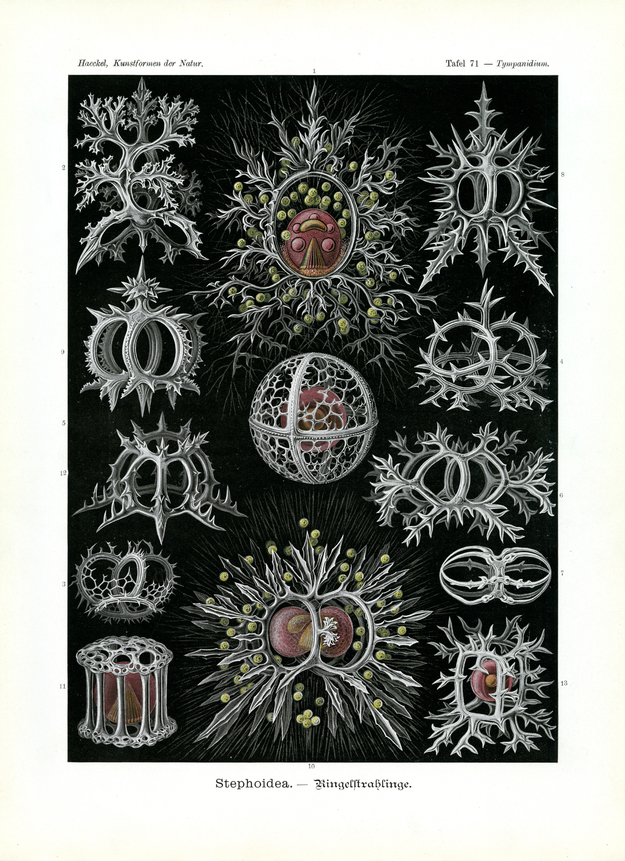Translation of the original German introduction by Ernst Haeckel:
Phylum of Protozoa (Urtiere); - main class of Rhizopoda (Wurzelfüßer); - class of Radiolaria (Strahlinge); - legion of Nassellaria (Korbstrahlinge or Monopyleen); - order of Stephoidea (Ringelstrahlinge).
The highly variable order of Stephoidea is closest related to that of Spyroidea (Nüßchenstrahlinge, plate 22) and Cyrtoidea (Flaschenstrahlinge, plate 31). As in all Nassellaria the central capsule is distinguished by a special ‘foot-cone’ (Podoconus) that rests underneath the nucleus (fig. 1, 10 and 11) and has a ‘pores-plane’ for the emission of innumerable delicate ‘plasma threats’ (Pseudopodia). The latter form a lime skeleton of most delicate and varied shape. The Calymma constitutes its substructure, a light coloured gelatinous cover that covers the central capsule and is interspersed by Pseudopodia. In most Radiolaria numerous yellow cells (fig. 1 and 10) rest inside the Calymma; they do not belong to the organism as such but are unicellular plants (Algariae) of the kind of Xanthella; they proliferate autonomously by separation and form , together with the Radiolaria, a union for mutual benefit (Symbiosis, cf. plate 51, fig. 2, 10, 11 and 12).
The order of Stephoidea comprises of four different families. In Stephanidae or “Kränzel-Radioaria” (fig. 1) a simple, vertically standing ring (Sattialring) comprises the basic part of the mineral skeleton. In case of Sematidae or “Signet-Radiants” (fig. 2) a second, horizontal ring is added, joined with the base of the vertical one (like the matrix of a signet ring). Coronidae, however, or “Crown-Radiolaria” (fig. 3-5), possess three rings resting in three levels, one perpendicularly standing on top of the other. Tympanidae, the fourth family, also “Drum-Radiants” (fig. 6-13) are characterized by two horizontal rings connected by one or several vertical rings.
Translation by VR Translators Bangalore
We've scanned the original lithography at 1200dpi on the Epson A3 scanner of A3 scanner huren. You can download a 400dpi JPEG here.
